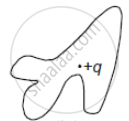Advertisements
Advertisements
Question
Find out the outward flux to a point charge +q placed at the centre of a cube of side ‘a’. Why is it found to be independent of the size and shape of the surface enclosing it? Explain.
Solution
Let a cube of side a enclose charge +q at its centre.
Because the electric flux through the square surface is `phi=q/(6in_0)`the square surfaces of cube are six. Hence, according to Gauss’s theorem in electrostatics, the total outward flux due to a charge +q of a cube is
`phi=6xx(q/(6in_0))=q/in_0`
The result shows that the electric flux passing through a closed surface is proportional to the charge enclosed. In addition, the result reinforces that the flux is independent of the shape and size of the closed surface.
APPEARS IN
RELATED QUESTIONS
Consider a uniform electric field E = 3 × 103 `bbhat i` N/C.
- What is the flux of this field through a square of 10 cm on a side whose plane is parallel to the yz plane?
- What is the flux through the same square if the normal to its plane makes a 60° angle with the x-axis?
Given a uniform electric filed \[\vec{E} = 4 \times {10}^3 \ \hat{i} N/C\]. Find the flux of this field through a square of 5 cm on a side whose plane is parallel to the Y-Z plane. What would be the flux through the same square if the plane makes a 30° angle with the x-axis?
Two charges of magnitudes −2Q and +Q are located at points (a, 0) and (4a, 0) respectively. What is the electric flux due to these charges through a sphere of radius ‘3a’ with its centre at the origin?
Two charges of magnitudes −3Q and + 2Q are located at points (a, 0) and (4a, 0) respectively. What is the electric flux due to these charges through a sphere of radius ‘5a’ with its centre at the origin?
A uniform electric field of intensity 400 N/C, exists in a certain region. How much flux will cross a given area of 10 cm2 in this region, if the area vector is inclined at 60° to the direction of the field?
The electric flux through the surface ______.
 |
 |
 |
 |
| (i) | (ii) | (iii) | (iv) |
A cylinder of radius R and length L is placed in a uniform electric field E parallel to the cylinder axis. The total flux for the surface of the cylinder is given by ______.
A charge Qµc is placed at the centre of a cube the flux coming from any surface will be.
The S.I. unit of electric flux is ______
